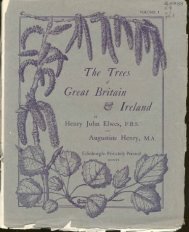THE METAMORPHOSES OF PUBLIUS OVIDIUS NASO
THE METAMORPHOSES OF PUBLIUS OVIDIUS NASO
THE METAMORPHOSES OF PUBLIUS OVIDIUS NASO
You also want an ePaper? Increase the reach of your titles
YUMPU automatically turns print PDFs into web optimized ePapers that Google loves.
TABULA I.<br />
IMPIETAS MINYEIDUM: DERCETIS: SEMIRAMIS: NA1AS.<br />
The Thoban dames receive Bacchus at his festival, except Alcithoo and her<br />
sistere, the daughters of Minyas, who remain at homo, carding and spinning.<br />
To divert the time, one of them proposes to tell each a Btory in her turn. She<br />
hesitates whether she will tell the story of Dercetis changed into a fish, or<br />
the story of Semiramis changed into a dove, or that of Naias, or of the Tree<br />
whose fruit, formerly white, was changed into the color of blood. This last<br />
was preferred, as the story was not common.<br />
EXPLICATIO.<br />
IN the account of the daughters of Minyas, some reference appears to<br />
be had to the Flood, for Minyas is described as a son of Neptune; and<br />
Nicolaus Damascenus says, that Baris (Ararat), where the Ark rested,<br />
ig above the country of the Minyse. Two of their names, as given by<br />
Antoninus, were compounded in part of hippa, which is regarded as a<br />
priestess of the hippos, or Ark. They probably adhered to the formei<br />
rites of Bacchus, and resisted the corruptions that were introduced. In<br />
the first part of this Fable, the names and titles of Bacchus are given,<br />
and a brief, but lively description of the pageant of the procession. There<br />
is also a lengthy apostrophe to Bacchus, which may be regarded in the<br />
light of a hymn to that deity. Dercetis, to whose story reference is<br />
briefly made by one of the sisters, is doubtless an hieroglyphic or emblem<br />
intended to represent the Ark. It will be shown by the notes, that it<br />
was the receptacle of the gods, in other words, Noah and his family, who<br />
were regarded by their remote descendants with a reverence that after<br />
wards became worship ; just as the Baris of Osiris contained the Ogdoad,<br />
or eight gods of the Egyptians. Semiramis too, it will be seen, was a<br />
mythological, and not an historical personage, and was no other than an<br />
emblem of the Dove which signified to Noah the end of the Delugt.<br />
The Ark, the Dove, and the Rainbow, were commemorated in many of<br />
the rites of the heathens, and traces of the Arkite story are to be found<br />
among every people of the earth, showing the universality of the tradi<br />
tion. The Naiad referred to in the Fable, according to Arrian, lived in<br />
Nosala, an island of the Erythrean sea, and after corrupting all the men<br />
that came to the island, changed them into fishes. The Ichthyophagi<br />
descended from them, after they were restored to the human form.<br />
The story of Pyramus and Thisbe, of Babylon, which forms the<br />
second Fable, is a continuation of the account of the Minyei'des, who<br />
are changed into bats, after the relation of the sad fate of the Babylonian<br />
Lovers.<br />
258<br />
x T non Alcithoe Minyeias Orgia censet<br />
Accipienda dei: sed adhuc temeraria, Bacchum<br />
Progeniem negat esse Jovis: sociasque sorores<br />
Impictatis habet. Festum celebrare sacerdos,<br />
Immuncsque operum dominas famulasque suorum, {<br />
Pectora pelle tegi, crinales solvere vittas,<br />
Serta Comis, manibus frondentes sumere thyrsos,<br />
Jusserat: et sffivam kesi fore numinis iram,<br />
NOT-flE.<br />
1. A t. By the use of this particle, the poet artfully connects this<br />
fable with the last one of the preceding book. Although Pentheua<br />
had been punished for his impiety, Alcithoe is unwilling to own the<br />
deiiy.<br />
1. Or^ia. Regarding Bacchus as a blending of the Scriptural Noah<br />
and Adam, and the rites of Bacchus as a commemoration of the Fall<br />
of Man, and of the Flood, it is possible that Spyia is derived from opyii,<br />
wrath, inasmuch as the anger of God was manifested at the expulsion<br />
from Paradise, when man was forced to till the earth, and at the Flood,<br />
when a guilty world was submerged for its impiety.<br />
3. Sororfs. Antoninus names the sis<br />
ters Alcithoe, Arsippa, and Leusippa.<br />
4. Sarcnloi The priest was most pro<br />
bably Tiresias, or Arrctes.<br />
fi. Ptlle tffi. To be clothed with<br />
skins. This was in commemoration of<br />
God s clothing our first parents, when man<br />
was ordered to till the ground. The skins<br />
of fawns and foxes were employed. The<br />
latter was probably an addition of later<br />
times. Foxes were slain because they hurt<br />
the vines.<br />
6. Crinales solvere. In these sacrifices,<br />
women were accustomed to let the ha'r<br />
flow dishevelled, in token of the distress<br />
of our general mother when rushing wildly<br />
forth from Eden, a wanderer over the earth<br />
8. -Eirst mtminis: of the insulted deity.<br />
If they should refuse to attend his rites.<br />
10. Calathot. Baskets in which they<br />
259













